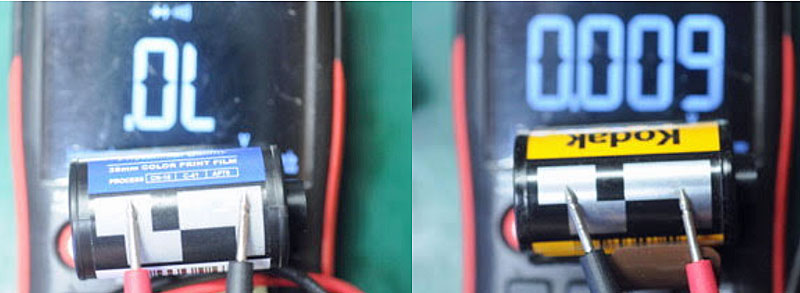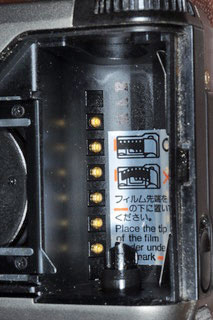An email came in last week from respected camera repair technician, Alan Roberston, from F16 Camera Service who had encountered an unusual issue with a high-end DX-coded camera.
He had been sent a Contax T2 which had suddenly stopped working. The owner had purchased a roll of ‘1Shot’ 400-speed film from a Camera House outlet and loaded it in the Contax. Nothing. She returned the camera to the retailer who advised her to update to a digital camera, so sent it to F16 for a second opinion.
With a premium titanium body and Zeiss Sonnar 38mm f2.8 lens the Contax T2 competed at the very top of the 35mm point-and-shoot market when it was released in 1991. A good quality T2 still commands $1000+ on the second hand market, so to have one suddenly stop working was disappointing, to say the least.

Alan unloaded the roll of 1Shot film and reloaded the camera with Kodak film and lo and behold! – it worked perfectly. When Alan applied his multimeter to the 1Shot cassette, it indicated that the 1Shot film didn’t have DX coding. (DX-coding on film cassettes relies on a pattern of conductive and non-conductive square patches to tell the DX-coded camera the speed of the film, as well as roll length and manufacturer.
 ‘The gold plated contacts’ [pictured right] ‘make contact with the conductive metal on the Kodak or other cassette. The patch on the end nearest the top of the cassette tells the camera the ISO. The patch on the bottom of the cassette tells the camera the film length.
‘The gold plated contacts’ [pictured right] ‘make contact with the conductive metal on the Kodak or other cassette. The patch on the end nearest the top of the cassette tells the camera the ISO. The patch on the bottom of the cassette tells the camera the film length.
‘With the 1Shot the label is a paper, non-conductive printer label which does not communicate to the camera at all.’
The 1Shot film is by no means a one-off. There is a lot of non DX-coded film out in the market, particularly with film bulk reloaders/’remanufacturers’ – such as 1Shot – filing the breach left by Fujifilm and Kodak. A Fujifilm Europe executive we spoke with recently estimated only around 50 percent of demand for film was being met globally.
The unusual, and for retailers, noteworthy, thing about the 1Shot film was that it appeared to have DX-coding on the cassette. The problem, as Alan noted, was the printed DX pattern had no electrical conductivity.
According to the specs for the Contax T2, it should simply default to ISO 100 when it can’t read the DX code from the film cassette. This would lead to chronic overexposure using 400 speed film, but at least the camera would take pics. This is also the case with many other DX-coded compact cameras. And of course with SLRs, the user can set ISO manually anyway. But, according to Alan, there is a sub-set of DX-code-equipped cameras out there which do need it.
‘More sophisticated cameras do need it,’ he said. ‘We have had many customers coming in since June thinking their cameras were faulty.
Whether the non-functioning DX-coding on the 1Shot film – as opposed to no DX-coding at all – caused the camera to simply refuse to take pics probably requires more experimentation. (If there are any readers out there who can cast more light on this, please comment below.)
We spoke to John Rule, managing director of local (Australia/NZ) distributor, Brands Australia, who noted, correctly, that the specs and packaging for the 1Shot film makes no claim that it is DX coded.
‘There is no “fake” DX-coding panel or any attempt as such,’ he explained. ‘The barcode sticker on the canister is based on EU photo industry OS requirements.’
He emphasised that ‘there’s been NO DX-coded cameras manufactured since mid-2000s.’
‘The only new 35mm cameras supplied today are reusable and are all mechanical, thus preset ISO. ISO can be manually set in a SLR.’
He acknowledged there was potential for confusion. ‘With future production, we will ask the factory to remove the sticker on the canister to remove any possible confusion, and print on the box “non DX coded, set ISO manually”,’ he said, as well as notifying retailer customers.
‘We’ve had the entire industry “cry out” for 35mm film and we’ve done our best to support our customers. We all see a massive resurgence for conventual film, as we have seen for some time now on Instant film.'(Brands Australia also distributes Polaroid.)
‘Our desire is nothing more than to support a return of our industry, back to it’s previous glory days,’ he added.
Inside Imaging understands there are many tens of thousands of rolls of the problematic film in distribution throughout Australia and New Zealand, Europe and East Asia.
FOOTNOTE: When researching this story we stumbled across a website which actually sells working DX-coding stickers! Who knew!
Go t0 https://cameractive.shop/products/iso-50-100-200-250-400-500-dx-code-labels-stickers-5pcs





You can also use my DX code generator:
https://davidslade.com.au/DX